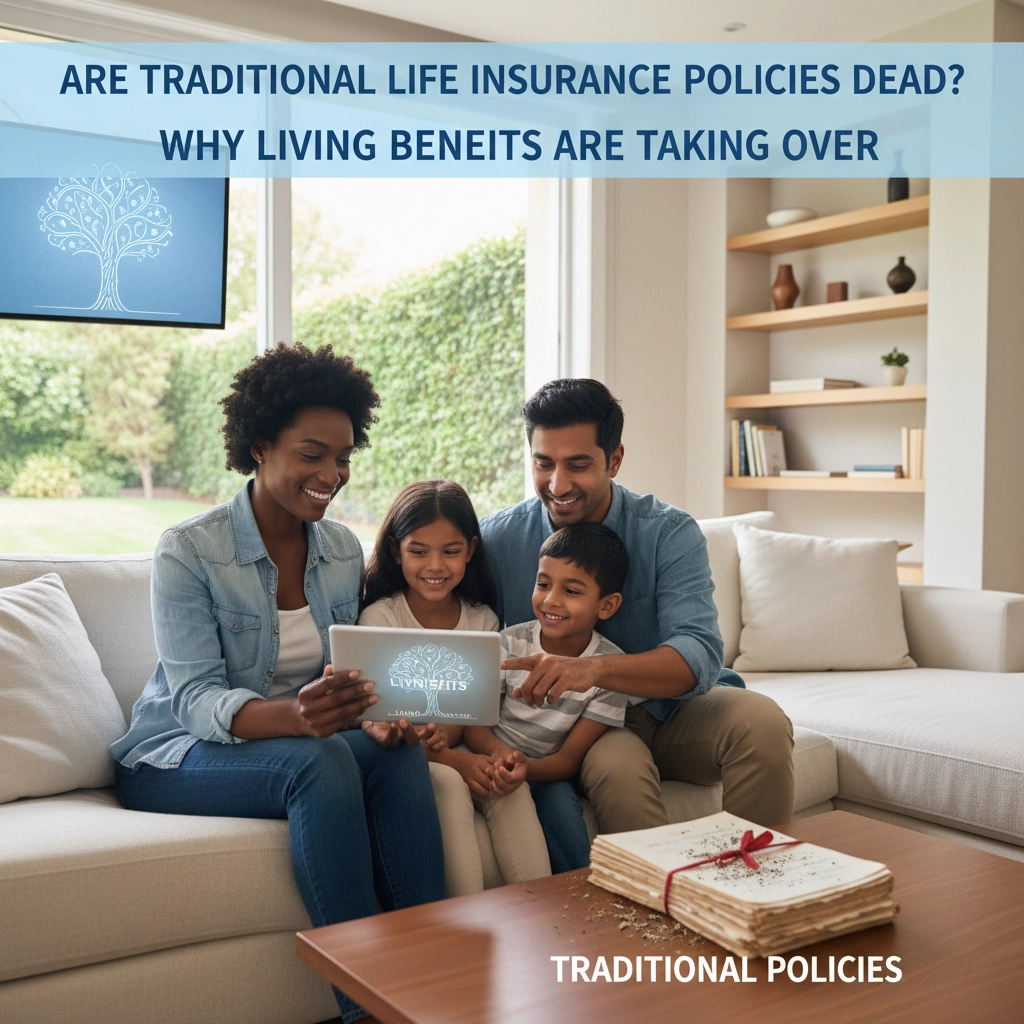Are Traditional Life Insurance Policies Dead? Why Living Benefits Are Taking Over

The life insurance landscape is experiencing a revolutionary shift that's changing how families think about financial protection. While traditional life insurance policies aren't completely obsolete, they're rapidly losing ground to innovative policies featuring living benefits. This transformation addresses a fundamental flaw in conventional coverage: why should your life insurance only benefit your loved ones after you're gone?
At Borde & Associates, we've witnessed this evolution firsthand over our years of serving families throughout the region. The data is clear: consumers, particularly those under 40, are demanding life insurance with living benefits that provides value during their lifetime, not just at death. Let's explore why this shift is happening and what it means for your family's financial security.
The Problem with Traditional Life Insurance
Traditional life insurance operates on a simple premise: you pay premiums for years, and your beneficiaries receive a death benefit when you pass away. While this provides essential family insurance planning, it leaves a critical gap in your financial protection during the years you need it most.

Consider this scenario: You're 45 years old with a $500,000 term life policy. You're diagnosed with a critical illness that requires extensive treatment and prevents you from working for months. Your traditional policy offers no assistance during this crisis: the financial burden falls entirely on your current savings and income. Your life insurance remains untouched until death, providing no relief when you desperately need it.
This limitation has created what industry experts call a "relevance crisis." Younger generations especially want financial tools that deliver tangible benefits throughout their working years, not just a future payout to beneficiaries. They're asking: "Why can't my life insurance help me if I face a health crisis while I'm alive?"
Understanding Living Benefits: Your Safety Net Today
Living benefits represent a fundamental reimagining of life insurance. These benefits allow you to access a portion of your death benefit while you're still alive if you face qualifying conditions such as:
- Terminal illness with a life expectancy of 12-24 months
- Critical illness like cancer, heart attack, or stroke
- Chronic illness requiring long-term care assistance
- Disability that prevents you from working
The beauty of living benefits lies in their flexibility. Instead of waiting for death to trigger your policy's value, you can access funds when life throws you a curveball. This transforms your life insurance from a passive protection tool into an active financial resource for your family.

How Living Benefits Work in Real Life
Let's revisit our earlier scenario with living benefits coverage: You have the same $500,000 policy, but this one includes living benefits riders. When diagnosed with your critical illness, you can access up to 80% of your death benefit: $400,000: to cover medical expenses, replace lost income, and maintain your family's financial stability during treatment.
Your remaining death benefit adjusts accordingly, but you've received crucial support when you needed it most. This immediate access to funds can mean the difference between financial devastation and manageable recovery for your family.
Why Families Are Choosing Living Benefits
The market success of living benefits speaks volumes about consumer demand. Insurance companies offering these enhanced policies are seeing unprecedented growth, with some reporting sales that exceed entire previous years within just months of launching living benefits products.
Financial Flexibility During Health Crises
Health insurance for families often falls short when facing major medical events. Even with comprehensive coverage, out-of-pocket maximums, lost income, and non-covered expenses can create financial hardship. Living benefits bridge this gap by providing access to your life insurance investment when you need it most.
Income Replacement Protection
When serious illness strikes, your ability to work: and earn income: may disappear temporarily or permanently. Living benefits can replace this lost income, ensuring your family maintains their standard of living during your recovery period.
Long-Term Care Security
With long-term care costs averaging $50,000-$100,000 annually, even well-prepared families can see their savings evaporate quickly. Living benefits provide a funding source for quality care without depleting your other assets.

Types of Living Benefits Available
Modern best living benefits life insurance policies offer various options to meet different family needs:
Accelerated Death Benefits
The most common living benefit, allowing access to your death benefit for terminal illness diagnoses. Most insurers include this rider at no additional cost.
Critical Illness Riders
Provide lump-sum payments upon diagnosis of covered critical illnesses like cancer, heart attack, or stroke. These riders typically cost additional premiums but offer substantial protection.
Chronic Care Riders
Allow monthly payments from your death benefit to cover long-term care expenses when you can't perform daily living activities independently.
Disability Income Riders
Replace a portion of your income if disability prevents you from working, providing ongoing financial support during recovery.
The Investment Perspective: Permanent vs. Term with Living Benefits
While term life insurance can include some living benefit riders, permanent policies like whole life or universal life naturally provide living benefits through their cash value component. These policies allow you to:
- Access cash value through loans or withdrawals
- Use accumulated value for any purpose
- Maintain death benefit protection for your beneficiaries
- Build tax-advantaged wealth over time
For families seeking comprehensive financial protection, permanent policies with enhanced living benefits often provide the most robust coverage.

Making the Right Choice for Your Family
Selecting between traditional coverage and life insurance with living benefits depends on your family's specific circumstances, age, health status, and financial goals. Consider these factors:
Your Age and Life Stage
Younger families often benefit more from living benefits, as they face decades of potential health risks before traditional life insurance would pay out.
Health History and Risk Factors
Families with genetic predispositions to certain illnesses may find living benefits particularly valuable for addressing future health challenges.
Existing Emergency Funds
If you lack substantial emergency savings, living benefits can serve as a critical financial backup for unexpected health crises.
Long-Term Care Planning
For families concerned about future care needs, living benefits provide an additional layer of security beyond traditional long-term care insurance.
The Cost-Benefit Analysis
Living benefits do increase policy premiums, typically by 10-25% depending on the riders selected. However, this additional cost often represents exceptional value when you consider:
- The probability of needing critical illness treatment during your lifetime
- The financial impact of long-term care expenses
- The peace of mind knowing your life insurance can help during health crises
- The tax advantages of accessing life insurance benefits
Working with Insurance Professionals
Given the complexity and importance of these decisions, partnering with experienced insurance professionals becomes crucial. At Borde & Associates, we help families navigate these options, ensuring they understand both the benefits and limitations of different coverage types.
Our approach involves:
- Comprehensive family needs analysis
- Comparison of traditional and living benefits options
- Cost-benefit analysis for your specific situation
- Ongoing policy review and adjustment as your needs change

The Future of Life Insurance
The trend toward living benefits represents more than a passing fad: it reflects a fundamental shift in how families approach financial security. As healthcare costs continue rising and people live longer, the need for accessible financial resources during health challenges will only grow.
Traditional life insurance will likely remain available for families seeking basic death benefit protection at the lowest cost. However, for comprehensive family financial planning, policies incorporating living benefits increasingly represent the gold standard.
The question isn't whether traditional life insurance is dead, but whether it adequately serves your family's complete protection needs. Living benefits transform life insurance from a single-purpose death benefit into a multi-faceted financial tool that serves your family throughout your lifetime.
For families ready to explore how living benefits can enhance their financial security, we invite you to contact our team for a comprehensive consultation. Your family deserves insurance that works as hard as you do: both today and tomorrow.
#LivingBenefits #LifeInsurance #FamilyProtection #FinancialSecurity #InsuranceTrends #2026Coverage #SmartFinance

No comments:
Post a Comment